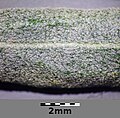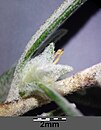European horn message
| European horn message | ||||||||||||
|---|---|---|---|---|---|---|---|---|---|---|---|---|

European horned horn ( Krascheninnikovia ceratoides ) in Lower Austria |
||||||||||||
| Systematics | ||||||||||||
|
||||||||||||
| Scientific name | ||||||||||||
| Krascheninnikovia ceratoides | ||||||||||||
| ( L. ) Gueldenst. |
The European horn signaling ( Krascheninnikovia Ceratoides ) and European horn alarm , Eastern Horn reporting and felted Horn seed called, is a plant species in the subfamily of chenopodioideae within the family of amaranthaceae (Amaranthaceae). It is widespread in Central and Southwest Asia and occurs in a few growth locations in Europe as a relic of the Ice Age cold steppes .
features
Vegetative characteristics
The European Hornmelde is a subshrub that reaches heights between 20 and 100 cm. The ( allo- ) homorhize rooting consists of a strong tap root with long cord and side roots . From the richly branched base arise perennial and annual shoot axes . The woody stems are heavily branched. The branches usually hang down arching or are overhanging. The 2 to 3 mm long stalked leaves are usually 20 to 40 mm long and 4 to 10 mm wide, with entire margins, lanceolate to eilanceolate, pointed and slightly rolled up at the edge. The above-ground parts of the plant are densely covered with six to eight-pointed star hairs measuring 0.2 to 0.4 mm in diameter.
Generative characteristics
The European Hornmelde is single sexed ( monoecious ). The flower sprouts are erect and grape-like. The unisexual flowers appear between July and September. The male flowers form a dense, terminal, compound false ear . The false ear consists of lateral, 0 to 1 mm long stalked and about 10 to 20 mm long "spikelets" of about 5 to 10 multi-flowered clusters, which are mostly in the axilla of a 3 to 7 mm long bract . The male flowers measure approximately 1.5 mm in diameter and have four occupied with star hair tepals but no bracts . The female flowers sit at the base of the "spikelets" individually in the axils of the leaves. The female flowers have no tepals, but star-haired bracts with numerous, very dense, approximately 6 mm long and finally brownish bristles at the base. The two 3 to 4 mm long before leaves are 2/3 to 3/4 fused when the fruit is ripe and completely enclose the nut fruit . The shell, which has two horns at the top, gave the Hornmelde its German species name. There are two scars 1.5 to 2 mm long .
Chromosome number
The number of chromosomes is 2n = 36.
ecology
The European Hornmelde is a nanophanerophyte . A clear connection to certain plant communities is not recognizable. It was named as a characteristic of Agropyro-Kochion, the "semi-ruderal loess edge corridor".
Occurrence
The European Hornmelde is a Mongolian - South Siberian - Oriental- Turkic-Pontic flora element and has its main distribution area in Central and Southwest Asia. In Europe, it appears like an island in Spain , Transylvania of Ukraine and in the Pannonian area of Austria on. The species is now extinct in the Czech Republic and Hungary . The European occurrences are considered to be the cold steppe relic of the last ice age. The European Hornmelde thrives on gravelly and rocky mountain steppes, as well as on dry loess slopes . It is believed to be a pointer plant for boron .
The Austrian sites are on the western exposed steep slope of the Blauer Berg near Oberschoderlee and in two Lösshohlwege near Goggendorf , both in the Lower Austrian Weinviertel . The occurrence near Goggendorf was discovered in 1912 by Alois Teyber, that near the Blauer Berg shortly afterwards by Pastor Ripper. According to Gustav Wendelberger , it is one of the oldest relic occurrences in the Pannonian region. Günther Beck , on the other hand, classified the deposits in 1890 as “probably only brought in as the Oriente” due to the ruderal locations.
Hazard and protection
In Lower Austria, the European horn report is considered to be endangered. In Oberschoderlee, the Niederösterreichischer Naturschutzbund and the municipality of Stronsdorf are constantly taking protective measures such as the removal of competing trees.
Systematics
This species was first published as Axyris ceratoides by Carl von Linné . Johann Anton Güldenstädt wrote it in Novi Comment in 1772 . Acad. Sci. Imp. Petrop. , 16, p. 555 moved to the genus Krascheninnikovia .
Synonyms for Krascheninnikovia ceratoides (L.) Gueldenst. which are based on the same type specimen are Axyris ceratoides L. , Diotis ceratoides (L.) Willd. and Eurotia ceratoides (L.) CAMey. Further synonyms are Ceratoides latens (JFGmel) Reveal & NHHolmgren , Ceratoides papposa Botsch. & Ikonn. , Ceratospermum papposum Pers. , Krascheninnikovia latens J.F. Gmel. and Eurotia lenensis Kumin. , Krascheninnikovia lenensis (Kumin.) Tzvelev and Eurotia ferruginea Moq.
photos
Location Blauer Berg near Oberschoderlee
Find location Reiternweg near Goggendorf
literature
- Manfred A. Fischer , Karl Oswald, Wolfgang Adler: Excursion flora for Austria, Liechtenstein and South Tyrol. 3rd, improved edition. State of Upper Austria, Biology Center of the Upper Austrian State Museums, Linz 2008, ISBN 978-3-85474-187-9 .
Individual evidence
- ↑ a b c d e f Manfred A. Fischer, Karl Oswald, Wolfgang Adler: Excursion flora for Austria, Liechtenstein and South Tyrol . 3rd, improved edition. Province of Upper Austria, Biology Center of the Upper Austrian State Museums, Linz 2008, ISBN 978-3-85474-187-9 , p. 358 .
- ↑ a b c d e f Arndt Kästner, Manfred A. Fischer: Portraits of selected rare Austrian vascular plant species (IV): (31) to (41). In: Association for the exploration of the flora of Austria (Ed.): Neilreichia , Volume 6, 2011, ISSN 1681-5947
- ↑ a b Entry in Tropicos , accessed February 20, 2012
- ↑ Manfred A. Fischer : Relics of the ice age to early ice age loess vegetation. In: Heinz Wiesbauer and Herbert Zettel: Hollow paths and loosing terraces in Lower Austria , Vienna 2014, ISBN 3-901542-42-6
- ^ Krascheninnikovia on the Germplasm Resources Information Network (GRIN), USDA , ARS , National Genetic Resources Program. National Germplasm Resources Laboratory, Beltsville, Maryland.
- ↑ Pertti Uotila, 2011: Chenopodiaceae (pro parte majore): Krascheninnikovia ceratoides - In: Euro + Med Plantbase - the information resource for Euro-Mediterranean plant diversity. , accessed February 20, 2012
Web links
- Datasheet for European horns in botany in the picture - Flora of Austria , 2005.
- Distribution map for Europe
- Illustration in: Helmut Freitag et al .: Chenopodiaceae . In: Flora of Pakistan , Vol. 204 - Missouri Botanical Garden Press & University of Karachi. 2001, ISBN 1930723105






